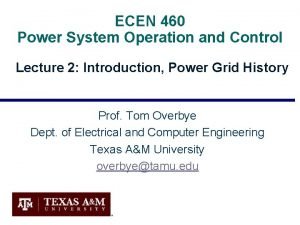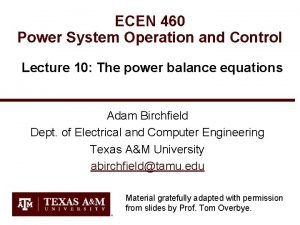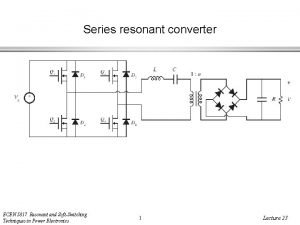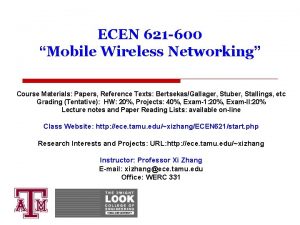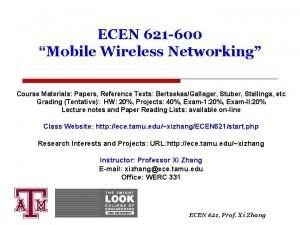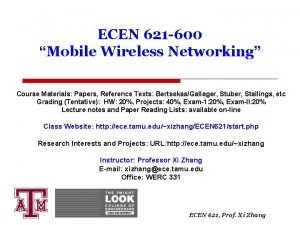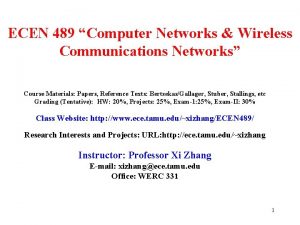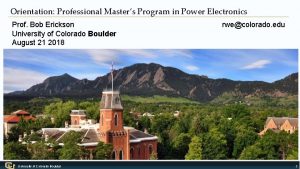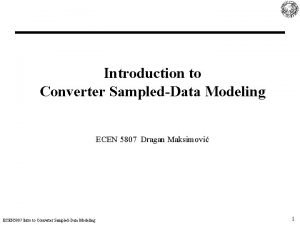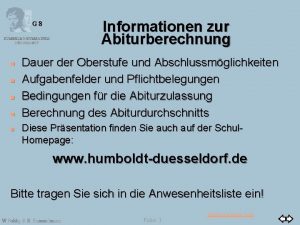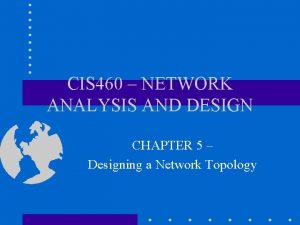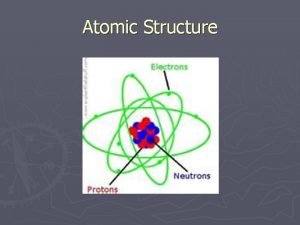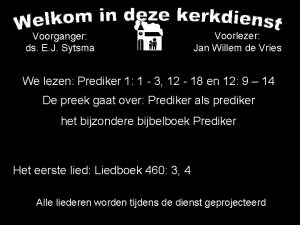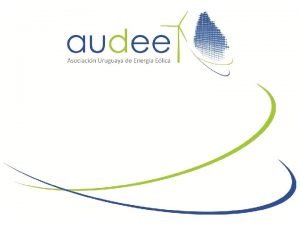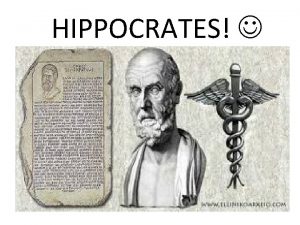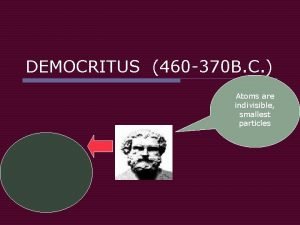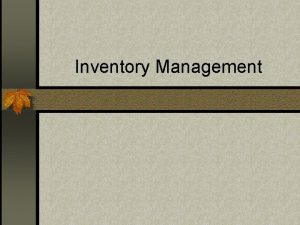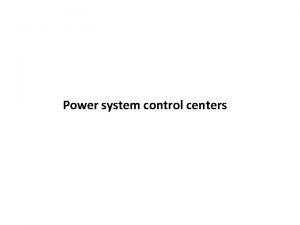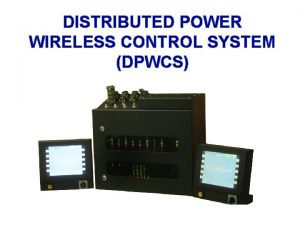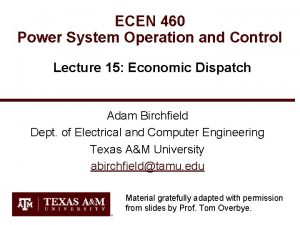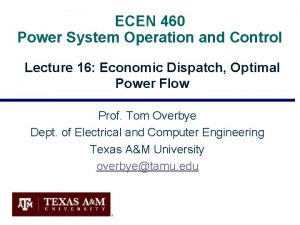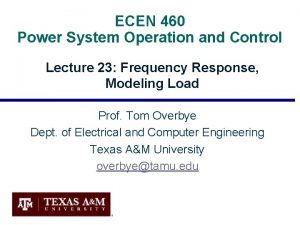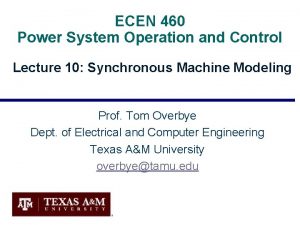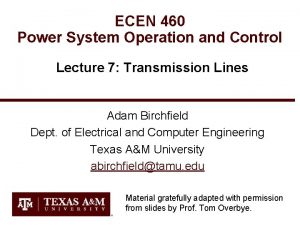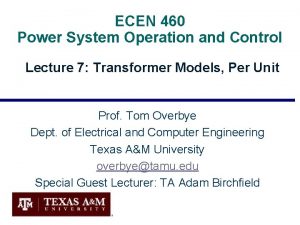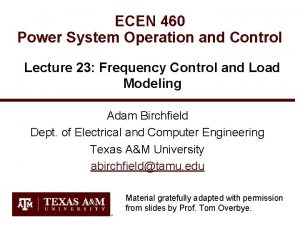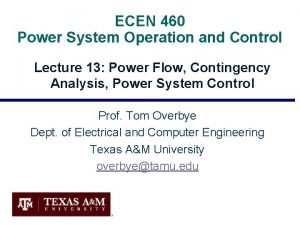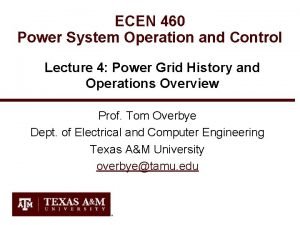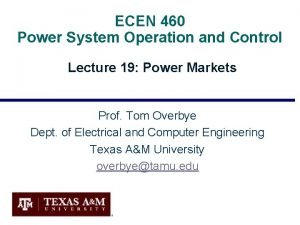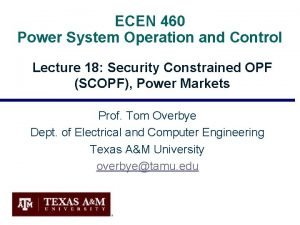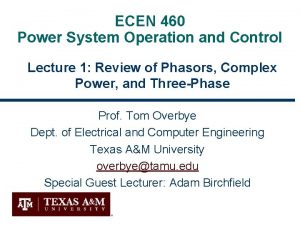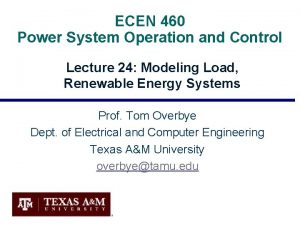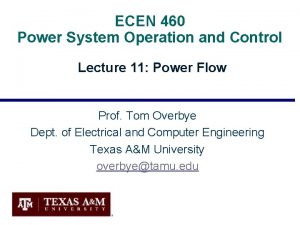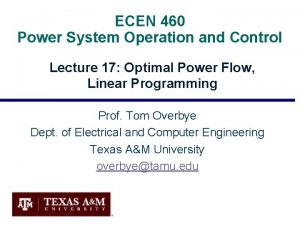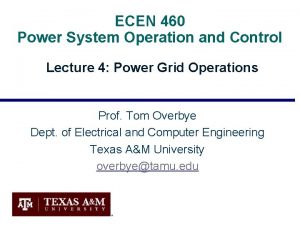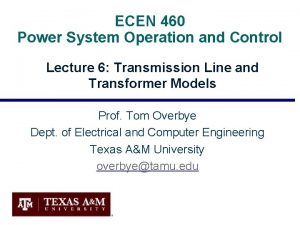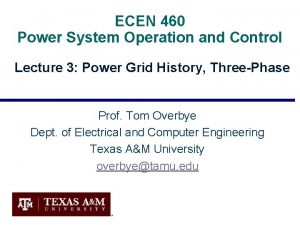ECEN 460 Power System Operation and Control Lecture






































- Slides: 38

ECEN 460 Power System Operation and Control Lecture 9: Power Flow, Synchronous Machines Prof. Tom Overbye Dept. of Electrical and Computer Engineering Texas A&M University overbye@tamu. edu

Announcements • Please read Chapter 2. 4, and 6. 1 to 6. 6 • HW 4 is 6. 9, 6. 12, 6. 18, 6. 25 (on 6. 25 just know how to do one iteration) – It should be done before the first exam, but need not be turned in. • Lowest two homework scores will be dropped • First exam is Thursday Oct 5 in class; one of my old exams is posted for reference; closed book, closed notes, one 8. 5 by 11 inch note sheet allowed; calculators allowed 1

Stopping Criteria 2

Gauss Power Flow 3

Gauss Two Bus Power Flow Example • A 100 MW, 50 Mvar load is connected to a generator • through a line with z = 0. 02 + j 0. 06 p. u. and line charging of 5 Mvar on each end (100 MVA base). Also, there is a 25 Mvar capacitor at bus 2. If the generator voltage is 1. 0 p. u. , what is V 2? SLoad = 1. 0 + j 0. 5 p. u. 4

Gauss Two Bus Example, cont’d 5

Gauss Two Bus Example, cont’d 6

Gauss Two Bus Example, cont’d 7

Slack Bus • In previous example we specified S 2 and V 1 and then solved for S 1 and V 2. • We can not arbitrarily specify S at all buses because total generation must equal total load + total losses • We also need an angle reference bus. • To solve these problems we define one bus as the "slack" bus. This bus has a fixed voltage magnitude and angle, and a varying real/reactive power injection. 8

Stated Another Way • Consider a three bus system with the specified transmission line impedances • This Ybus is actually singular! • So we cannot solve • This means (as you might expect), we cannot independently specify all the current injections I 9

Gauss with Many Bus Systems 10

Gauss-Seidel Iteration 11

Three Types of Power Flow Buses • There are three main types of power flow buses – – – Load (PQ) at which P/Q are fixed; iteration solves for voltage magnitude and angle. Slack at which the voltage magnitude and angle are fixed; iteration solves for P/Q injections Generator (PV) at which P and |V| are fixed; iteration solves for voltage angle and Q injection • special coding is needed to include PV buses in the Gauss-Seidel iteration (covered in book, but not in slides since Gauss-Seidel is no longer commonly used) 12

Accelerated G-S Convergence 13

Accelerated Convergence, cont’d 14

Gauss-Seidel Advantages/Disadvantages • Advantages – – Each iteration is relatively fast (computational order is proportional to number of branches + number of buses in the system Relatively easy to program • Disadvantages – – Tends to converge relatively slowly, although this can be improved with acceleration Has tendency to miss solutions, particularly on large systems Tends to diverge on cases with negative branch reactances (common with compensated lines) Need to program using complex numbers 15

Newton-Raphson Algorithm • The second major power flow solution method is the Newton-Raphson algorithm • Key idea behind Newton-Raphson is to use sequential linearization 16

Newton-Raphson Method (scalar) 17

Newton-Raphson Method, cont’d 18

Newton-Raphson Example 19

Newton-Raphson Example, cont’d 20

Sequential Linear Approximations Function is f(x) = x 2 - 2 = 0. Solutions are points where f(x) intersects f(x) = 0 axis At each iteration the N-R method uses a linear approximation to determine the next value for x 21

Newton-Raphson Comments • When close to the solution the error decreases quite quickly -- method has quadratic convergence • f(x(v)) is known as the mismatch, which we would like to drive to zero • Stopping criteria is when f(x(v)) < • Results are dependent upon the initial guess. What if we had guessed x(0) = 0, or x (0) = -1? • A solution’s region of attraction (ROA) is the set of initial guesses that converge to the particular solution. The ROA is often hard to determine 22

Multi-Variable Newton-Raphson 23

Multi-Variable Case, cont’d 24

Multi-Variable Case, cont’d 25

Jacobian Matrix 26

Multi-Variable Example 27

Multi-variable Example, cont’d 28

Multi-variable Example, cont’d 29

Synchronous Machine Modeling • Electric machines are used to convert mechanical energy into electrical energy (generators) and from electrical energy into mechanical energy (motors) – Many devices can operate in either mode, but are usually customized for one or the other • Vast majority of electricity is generated using synchronous generators and some is consumed using synchronous motors • Much literature on subject, and sometimes overly confusing with the use of different conventions and nomenclature 30

Synchronous Machine Basics • Two basic parts – – – Stator (or armature) is the stationary outside of the machine Rotor is the internal part that rotates Stator and rotor are separated by an airgap, which is needed to allow the rotor to spin • Synchronous machines are named because in steady state the rotor spins at a speed proportional to the electrical frequency (i. e. , it stays in synch with the electrical frequency) • Can be either three-phase or single-phase; we’ll just consider three-phase machines 31

Synchronous Machine Basics • The rotor has a dc field current that is used to produce a magnetic field – – There needs to be some electrical connection between the spinning rotor and stationary stator to provide this current Occasionally the rotor is a permanent magnetic, but this limits control of the machine • The three stator windings have a three-phase, voltage. In a motor or interconnected generator this voltage is supplied. In a stand along generator it is induced. • The electric currents in the stator create a rotating magnetic field; rotor runs “in synch” with this field 32

Synchronous Machine Modeling 3 bal. windings (a, b, c) – stator Field winding (fd) on rotor Damper in “d” axis (1 d) on rotor 2 dampers in “q” axis (1 q, 2 q) on rotor 33

Rotating Magnetic Field Demo 34

Rotation Speed and Two Main Types of Synchronous Machines • Machines may have multiple pole pairs to spin at speeds slower than the electrical frequency • Round Rotor – Air-gap is constant, used with higher speed machines • Salient Rotor (often called Salient Pole) – – Air-gap varies circumferentially Used with many pole, slower machines such as hydro 35

Synchronous Machine Rotors • Rotors are essentially electromagnets Two pole (P) round rotor Image Source: Dr. Gleb Tcheslavski, ee. lamar. edu/gleb/teaching. htm Six pole salient rotor 36

Synchronous Machine Rotors High pole salient rotor Shaft Part of exciter, which is used to control the field current Image Source: Dr. Gleb Tcheslavski, ee. lamar. edu/gleb/teaching. htm 37
 Ecen 460
Ecen 460 Ecen 460
Ecen 460 Ecen 5817
Ecen 5817 Ecen 621
Ecen 621 Ecen 621
Ecen 621 Ecen 621
Ecen 621 Ecen 489
Ecen 489 Colorado boulder power electronics
Colorado boulder power electronics Ecen 5807
Ecen 5807 Power system dynamics and stability lecture notes
Power system dynamics and stability lecture notes Power system dynamics and stability lecture notes
Power system dynamics and stability lecture notes Power system analysis lecture notes
Power system analysis lecture notes 01:640:244 lecture notes - lecture 15: plat, idah, farad
01:640:244 lecture notes - lecture 15: plat, idah, farad Power traiangle
Power traiangle Atomic model diagram democritus
Atomic model diagram democritus Khrihfa hlabu 460
Khrihfa hlabu 460 460 punkte abitur
460 punkte abitur Porsche rental new orleans
Porsche rental new orleans Cis 460
Cis 460 What scientist discovered the electron
What scientist discovered the electron Liedboek 460
Liedboek 460 Historical figures in healthcare
Historical figures in healthcare Onlua
Onlua Sen 460
Sen 460 Multis complex shd 460
Multis complex shd 460 St460ts
St460ts When was hippocrates born
When was hippocrates born Hs 460
Hs 460 Democritus 460 bc
Democritus 460 bc Storage and inventory control examples
Storage and inventory control examples Power angle curve in power system stability
Power angle curve in power system stability Power semiconductor devices lecture notes
Power semiconductor devices lecture notes Switch mode power supply lecture notes
Switch mode power supply lecture notes Power system control centre
Power system control centre Distributed power wireless control system
Distributed power wireless control system Control unit operation
Control unit operation System implementation and operation
System implementation and operation Solar power satellites and microwave power transmission
Solar power satellites and microwave power transmission Potential power
Potential power
